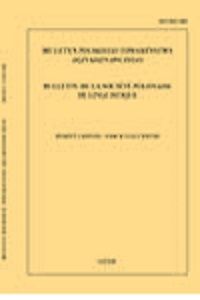Zmiany w języku vs zmiany języka
Changes in Language vs. Language Change
Author(s): Krystyna KleszczowaSubject(s): Lexis, Semantics
Published by: Polskie Towarzystwo Językoznawcze
Keywords: language change; neologism; extinction of a grammatical category; language redundancy; formation of a grammatical category;
Summary/Abstract: Language, as a highly complex and open system, is undergoing constant changes, even though the majority of innovations appear at the edges of language structure. The first part of the paper concerns innovations which came out of use after several decades, i.e. neologisms and series of neologisms that were once fashionable. It is more difficult to evaluate inflectional and syntactic changes, for the linguistic norm is guarded by proofreaders employed by publishing houses. It might be helpful to examine the questions sent to linguistic advice institutions and the use of replacement strategies (not dwoje nożyczek ‘two scissors’ but dwie pary nożyczek ‘two pairs of scissors’; not łomżanin ‘Łomża-er’ but mieszkaniec Łomży ‘resident of Łomża’; not ciasto rodzynkowe ‘raisin cake’ but ciasto z rodzynkami ‘cake with raisins’). Language changes happen in an almost imperceptible way and they usually go unnoticed by speakers of a language, sometimes even by linguists. The (gradual) disappearance of a grammatical rule is a slow process; a rule may leave some traces that are visible a few centuries later (e.g. dobroć ‘goodness’, szlachcic ‘nobleman’, bracia ‘brothers’). A newly-developing grammatical rule usually supplants a whole range of variant ways of conveying information and limits redundancy in language. This is exemplified with the existential negation of Polish być ‘to be’ in the present tense (jest ‘(it/there) is’ vs. nie ma ‘it/there isn’t’) and with the category of comparison.
Journal: Biuletyn Polskiego Towarzystwa Językoznawczego
- Issue Year: LXXIX/2023
- Issue No: 79
- Page Range: 339-353
- Page Count: 15
- Language: Polish

